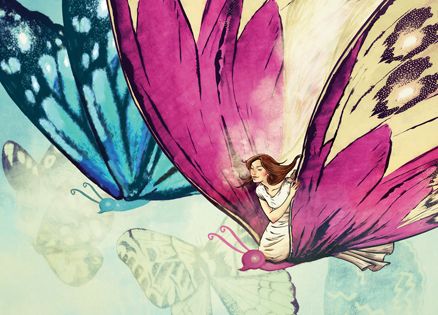I’ve been a neurosurgeon for more than 20 years. Over that time, I’ve heard a lot about angels.
Angels who have shown up in patients’ recovery rooms after a rough surgery, angels who come in dreams to comfort friends of a patient, and angels who visit mourning relatives. Angels who always seem extraordinarily real to the people who see them.
Such people cite convincing details about their angel’s appearance, so the angels don’t seem vague or imaginary at all.
I listened to these stories with sympathy. Neurosurgeons deal with the brain, the single most complex, and least understood, organ in the body. Operating on the brain can be highly traumatic both for patients and their loved ones. So I’d nod my head and say that such blessed events could happen.
Not that I believed any of these angels were real.
The brain is a fantastically efficient machine—efficient enough that if traumatized by illness or surgery, it can actually fool itself into getting better by generating healing imagery. Imagery like a guardian angel, complete with white robes and wings and whatever else a patient might find most comforting.
When patients experienced angelic visitations like this, they were simply benefiting from the marvelously efficient mechanisms that the brain possesses that allow it to automatically soothe and heal itself.
Of course, I never said any of this to my patients. These kinds of experiences can be hugely helpful. It was not my place to burst the bubble of a patient who wanted to believe in angels. If it helped a patient get better, then she could believe in anything she wanted.
So you can imagine my surprise when, during the week beginning the tenth of November 2008, I encountered my own guardian angel.
I awoke in my wife Holley’s and my Lynchburg, Virginia, house an hour earlier than usual, with a nasty backache. Thinking it was left over from the low-grade flu that Holley, our younger son, Bond, and I had been suffering from all week, I tiptoed down to the bathroom and ran a hot tub.
The hot water only made the pain worse. It spread to my head. I managed to get myself back to bed. I flopped facedown beside Holley, and she woke up and asked me what was wrong. A little later Bond awoke and came in as well. Hearing that I had a headache, he reached out and massaged my temples gently.
I screamed in agony. Holley wanted to call an ambulance, but I told her the pain would go away on its own. “Trust me,” I said. “I’m a doctor.”
Holley left me to rest quietly for a while and got Bond ready for school. She stayed out of the room for an hour and a half so as not to wake me. When she finally came back in, she found me lying rigid on the bed, my jaw jutting forward, my eyes rolled back in my head. I was having a full grand mal seizure.
Holley called for an ambulance, and 45 minutes later I was wheeled into Lynchburg General Hospital, where I’d worked for years. By that afternoon, I’d slid deep into a coma: one from which I would not recover for another seven days.
My doctors discovered that I’d contracted a disease, very rare in adults, called bacterial meningitis. Millions of E. coli bacteria had invaded my brain and spinal cord, and were literally eating my cortex—the outermost portion of the brain, and the part responsible for nearly everything that makes us human.
Thought, logic, emotion…it all comes from the cortex. By that Monday afternoon, mine was completely shut down with very, very little likelihood of it working ever again. My chances of survival were small. My chances of surviving as anything more than a vegetable essentially nonexistent.
Family and friends gathered at the hospital, and over the next seven days they kept a vigil at my bedside, praying for my recovery. For the first few days my doctors tried to stay hopeful. By day five, none of them believed I stood a chance of surviving.
So on day seven, they met with Holley and gave her the news that no doctor ever wants to have to deliver.
It was time to take me off life support—to let me die.
Just a room away, I lay in the position I had lain in all week—a ventilator tube down my throat, my face slack, my hands and feet beginning to curl up like leaves as my circulation gradually ebbed away from my limbs. Bond, inconsolable, sat by me, holding my hand.
My eyes popped open. Looking around me like a newborn, I took in a world that everyone believed I had left behind forever.
It took months for me to fully recover physically. I lost almost 20 pounds during my week in a coma, and my brain—miraculously unscathed despite the weeklong bacterial attack—had to work hard to find its bearings again in the physical world.
But the physical recovery was the easy part. There was something else that had to heal as well in the wake of my recovery. I guess you could call it my belief system.
I now believe in angels. Not in some abstract way, but in the same way that I “believe” my car is sitting in my driveway, in the same way that I “believe” that I love my family.
In other words, I don’t really “believe” in angels at all. I quite simply know they are real. During my seven days in a coma, I journeyed to a world above this one: a world indescribably vibrant, vivid, and—most importantly—real.
When I entered this world, the first thing—the first person—that I saw was a beautiful young woman. She had long golden-brown hair, deep-blue eyes, a simple dress of powder blue and indigo and pastel-orange peach. I realized we were riding on the wing of a butterfly!
In fact millions of butterflies surrounded us, vast fluttering waves of them, dipping down and coming back up around us again. It was a river of life and color, moving through the air.
As we floated along together above a landscape of staggering beauty—of trees and clouds and waterfalls—she spoke to me in a language beyond words. And what she told me was, in essence, the same thing that the “imaginary” angels had told all those patients of mine over the years.
That I was loved. That I was safe. That I would always, always be taken care of.
Today, I’m still a surgeon, and still a man of science. I still believe the brain is a staggeringly sophisticated machine, capable of the most extraordinary feats, both when well and when under attack by illness.
But today, when a patient tells me that he or she has been visited by an angel, I no longer marvel at how clever the brain is in creating such realistic illusions.
Angels, I now know, are not illusions at all. I know, because I learned it from my own angel. An angel with blue eyes, who I met on the wing of a butterfly.
Download your FREE ebook, Angel Gifts: Inspiring Stories and Angel Crafts to Nurture Your Creativity





